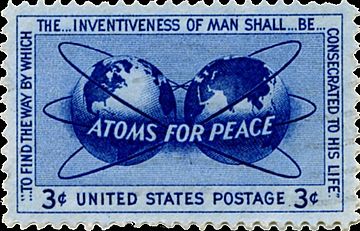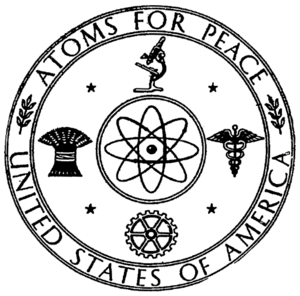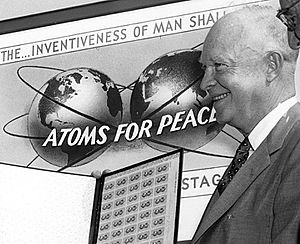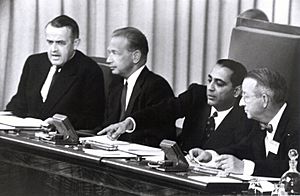Atoms for Peace facts for kids
"Atoms for Peace" was the name of an important speech. U.S. President Dwight D. Eisenhower gave this speech. He spoke to the United Nations General Assembly in New York City. This happened on December 8, 1953.
I feel impelled to speak today in a language that in a sense is new—one which I, who have spent so much of my life in the military profession, would have preferred never to use.
That new language is the language of atomic warfare.
After the speech, the United States started an "Atoms for Peace" program. This program gave equipment and information to schools, hospitals, and research places. It helped groups in the U.S. and around the world. For example, the first nuclear reactors in Israel and Pakistan were built under this program. An American company, known for making bowling equipment, built them.
Contents
What Was the Idea Behind Atoms for Peace?
The "Atoms for Peace" speech was part of a big media plan. This plan was called "Operation Candor". Its goal was to teach Americans about the good and bad sides of nuclear power. Both Operation Candor and Atoms for Peace were influenced by a report from 1953. This report said the U.S. government should be more honest. It wanted the government to tell people about the dangers of nuclear warfare. This made President Eisenhower want to find a new way to deal with the threat of nuclear war.
"Atoms for Peace" was also a way to influence public opinion. It was part of the Cold War strategy. The Cold War was a long period of tension between the U.S. and the Soviet Union. Eisenhower's speech started a campaign that lasted years. It tried to balance people's fears of nuclear weapons. At the same time, it promised peaceful uses for uranium in future nuclear reactors. The speech was a key moment. It made the world focus on using atomic energy for good, even during the early Cold War. Eisenhower wanted to calm a world that was scared. This fear came after the terrible events in Hiroshima and Nagasaki. It also came from nuclear tests in the early 1950s.
The program seemed to be the opposite of "brinkmanship". Brinkmanship was a risky way of dealing with other countries. It often brought the world close to war.
Some historians now think the speech had another goal. They believe it was mainly for U.S. allies in Europe. Eisenhower wanted European countries to agree with a change in NATO strategy. NATO is a military alliance. The U.S. wanted to use cheaper nuclear weapons instead of regular ones. Western Europeans needed to know that the U.S. would not start a nuclear war in Europe. The speech was mostly meant to give them that comfort. Eisenhower later said he knew the Soviets would not accept his specific offer in the speech.
Eisenhower talked about "universal peace and human dignity." These ideas are in the UN Charter. This put new focus on the U.S. responsibility for its nuclear actions. This speech also helped set the rules for the new kind of conflict: the Cold War.
How the Speech Changed Things
Before Eisenhower's speech, atomic development was very secret. The information and skills for atomic work were kept hidden. This was due to the secret Quebec Agreement of 1943. So, atomic power was not used for peaceful things. Instead, it was used to make weapons to defend against other countries. These other countries were also developing similar weapons. Because atomic development was so secret, there were no safety rules or standards.
Eisenhower's speech was a big moment in history. It brought the atomic issue into the public eye. Before, it had been kept quiet for "national security." He asked the world to support his solution. Eisenhower wanted to solve "the fearful atomic dilemma." He wanted to find a way for human inventions to be used for life, not for death. But Eisenhower was not fully successful in this. He himself approved a plan that said a huge atomic weapon supply was needed. This was to stop violence from the Soviet Union.
The idea was that to avoid a nuclear war, the U.S. had to be ready to strike at any time. This was also why the Soviet Union would not give up its atomic weapons. During Eisenhower's time as president, the U.S. nuclear weapons grew a lot. They went from 1,005 to 20,000 weapons.
The "Atoms for Peace" program opened up nuclear research to regular people. It also helped countries that did not have nuclear technology before. Eisenhower wanted a global agreement to stop the spread of military nuclear weapons. Countries that already had atomic weapons kept and grew their supplies. But very few other countries have developed similar weapons. In this way, the spread of weapons was mostly controlled. The "Atoms for Peace" program also created rules for using nuclear power. These rules helped stop countries from making weapons. They also allowed the technology to be used for good purposes.
What Lasted from Atoms for Peace?
Atoms for Peace helped create the International Atomic Energy Agency. It also led to the Treaty on the Non-Proliferation of Nuclear Weapons. But it also gave a reason for the U.S. to build up its nuclear weapons. It was part of the Cold War arms race. Under programs related to Atoms for Peace, the U.S. sent over 25 tons of highly enriched uranium (HEU) to 30 countries. This uranium was mostly for powering research reactors. Now, this is seen as a risk for spreading nuclear weapons and terrorism. The Soviet Union had a similar program. It sent over 11 tons of HEU.
Some research shows a link between peaceful nuclear cooperation and nuclear weapons programs. This is because the technology, knowledge, and materials from peaceful nuclear use can make it easier to build nuclear weapons.
See also
 In Spanish: Átomos para la Paz para niños
In Spanish: Átomos para la Paz para niños






